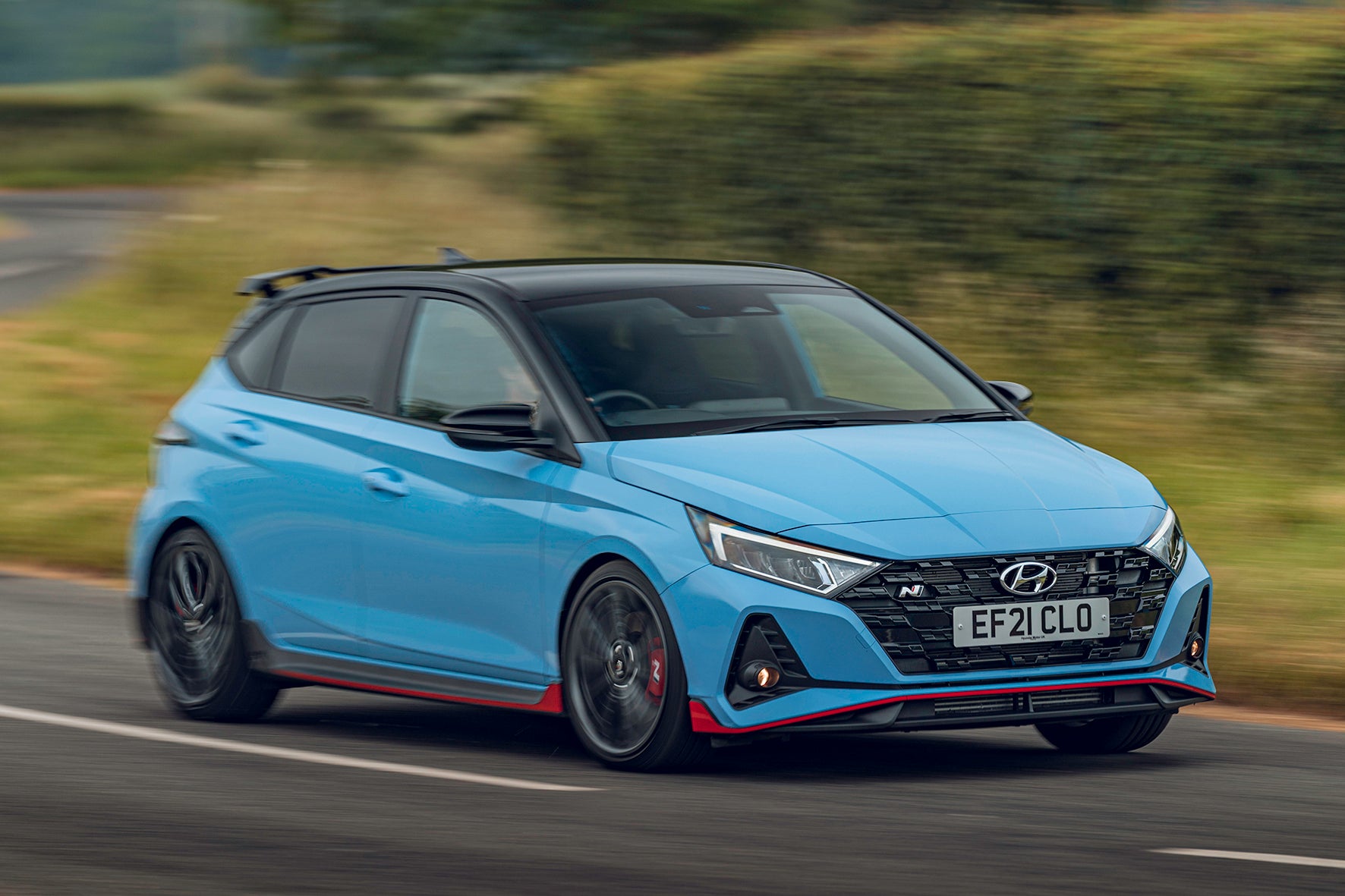Hyundai i20N Review 2025: Price, specs & boot space
Written by Ivan Aistrop
Quick overview
Pros
- Terrific fun when you’re in the mood
- Decent value for money
- Fairly well equipped
Cons
- Punishing ride
- Interior feels a bit drab
- Glitchy touchscreen
Overall verdict on the Hyundai i20N
"The Hyundai i20N is far from perfect, and some of its shortcomings are rather serious, but that doesn’t stop it from being something of a rough diamond. On the right sort of road, it has the capacity to thrill you like few other cars can, and it also has impressive space and practicality, generous kit, an amazing warranty and a tempting pricetag. Just make sure you know about those shortcomings in advance, and that you can live with them."
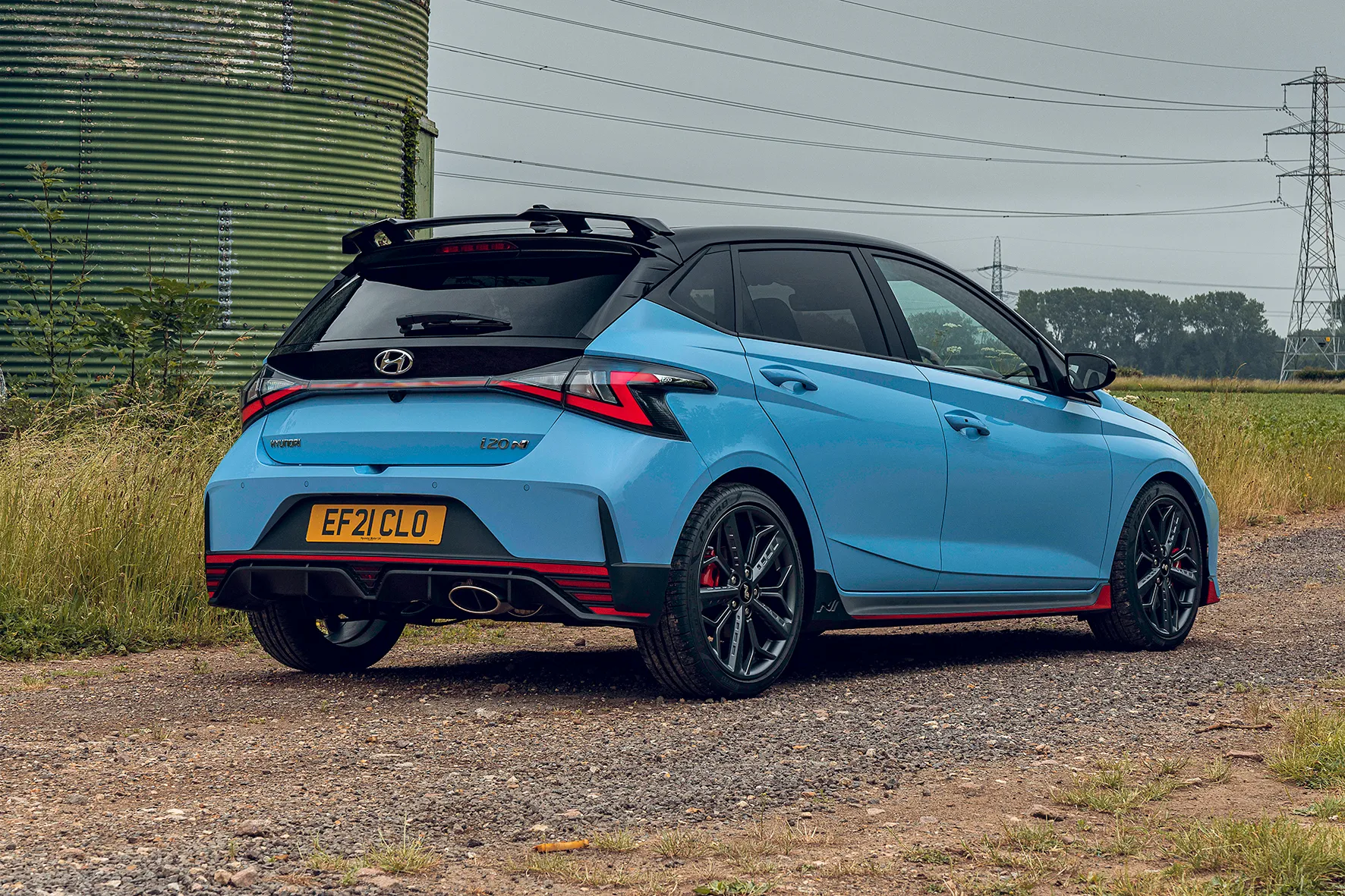
Not many car companies have managed to transform their public image in quite the way Hyundai has in recent years. Once a budget brand seen as little more than a figure of fun by British car buyers, the Korean carmaker is now comfortably ensconced within the mainstream, alongside well-established companies from Japan and Germany. And, not only does this huge manufacturing powerhouse make several models that sell by the absolute bucketload in the UK, but at the same time, it’s also producing some of the most interesting and desirable models on the market.
The company’s N division has been instrumental in this turnaround. Even a few short years ago, the idea of a high-performance Hyundai was a laughable one, but gradually over time, with a number of genuinely impressive N models under its belt, Hyundai’s N cars have become no laughing matter. Sure, the N division’s inexplicable obsession with the Nurburgring borders on the irritating, as does its fondness for hopelessly cheesy marketing monikers for fairly mainstream dynamic technology (‘N Grin Shift’, anyone?), but that doesn’t take away from the fact that Hyundai’s N cars are highly talented and highly engaging pieces of kit.
The Hyundai i20N might be the smallest and least powerful of them, but it has nothing less in the way of attitude. This 204PS pocket-rocket, powered by a turbocharged 1.6-litre four-cylinder petrol engine, looks brash and mean on the road, and with a 0-62mph sprint time of 6.2 seconds, it has the performance chops to back up the bluster.
It’s packing some fairly serious high-performance technology, too, such as a limited-slip differential, launch control, and selectable and configurable driving modes (that’s the bit that’s known as N Grin Shift, apparently - sigh!) that let you tailor the experience to your mood. In truth, whichever mode you pick, the Hyundai i20N is a no-nonsense, uncompromising, hard-edged hot hatchback that likes to be taken by the scruff of the neck, treated mean and driven hard. And when you oblige, it’ll reward you with thrill after thrill after thrill. If you don’t oblige, however, and you just want to get home after a long day at the office, it’s fair to say that the Hyundai i20N becomes somewhat less rewarding - more on that in a while.
In other ways, though, the Hyundai i20N follows the classic hot-hatch formula. Not only is it fast and fun, it also has enough space and practicality to cope with the daily grind, and it’s affordable enough, and well-equipped enough, to feel like good value for money.
Those looking for a super-small hot hatchback don’t have many choices these days, because many manufacturers have stopped offering them in favour of concentrating on building more humble, higher-selling variants. But if you are one of those people still interested in cars like this, then - provided you go in with your eyes open to its shortcomings - the Hyundai i20N is one of the best.
Looking for a used car for sale? We've got 100s of Hyundai Approved Used Cars for Sale for you to choose from, including a wide range of Hyundai i20N cars for sale.
Is the Hyundai i20N right for you?
If there’s a part of you that never quite grew up, and you like to indulge your inner hooligan every now and then, then the Hyundai i20N could be right up your street. This is a proper old-school miniature hot hatch, with bags of power, a rock-hard suspension and a proper ASBO attitude. It’s brilliant fun, and will never fail to put a smile on your face on the right road. Just be prepared for the fact that, when you’re not on the right road and you’re just trying to go about your daily life, you have to put up with some fairly hefty compromises.
What’s the best Hyundai i20N model/engine to choose?
This is a bit of a no-brainer where the Hyundai i20N is concerned, because it’s only available with one engine, one gearbox, and in one trim level. The engine is a turbocharged 1.6-litre four-cylinder petrol sending 201bhp to the front wheels via a six-speed manual gearbox and a limited slip differential. The single trim level includes kit such as 18-inch alloy wheels, heated front seats, automatic lights and wipers, cruise control, power folding door mirrors, keyless entry and go, rear parking sensors and a reversing camera, and only a handful of optional extras are available, those being paint, a contrasting black roof and a stereo upgrade.
What other cars are similar to the Hyundai i20N?
In truth, not many these days. Not so very long ago, you had your pick of countless small hot hatches, with fast versions of the Renault Clio, Peugeot 208, Seat Ibiza, Skoda Fabia, Fiat 500 and Vauxhall Corsa all vying for your attention, but these have now been discontinued, with only the sensible versions now remaining. Boo hiss.
Until recently, the Ford Fiesta ST was probably the Hyundai i20N’s most direct rival, but now, even that car has unfortunately gone the way of the Escort, with production stopping in 2023.
That leaves the N with very few direct rivals. The Suzuki Swift Sport is cheaper and less powerful, while the incredible Toyota GR Yaris is both pokier and pricier. Its most direct rival on both counts is probably the Volkswagen Polo GTI, but there’s an appreciable price difference there, too, and the VW is more brisk cruiser than seat-of-the-pants hot hatch.
Comfort and design: Hyundai i20N interior
"For a small car, the Hyundai i20N is impressively roomy for both passengers and luggage, so it delivers the practicality you need in a hot hatch. However, the interior could feel posher and the infotainment software can be prone to glitches."
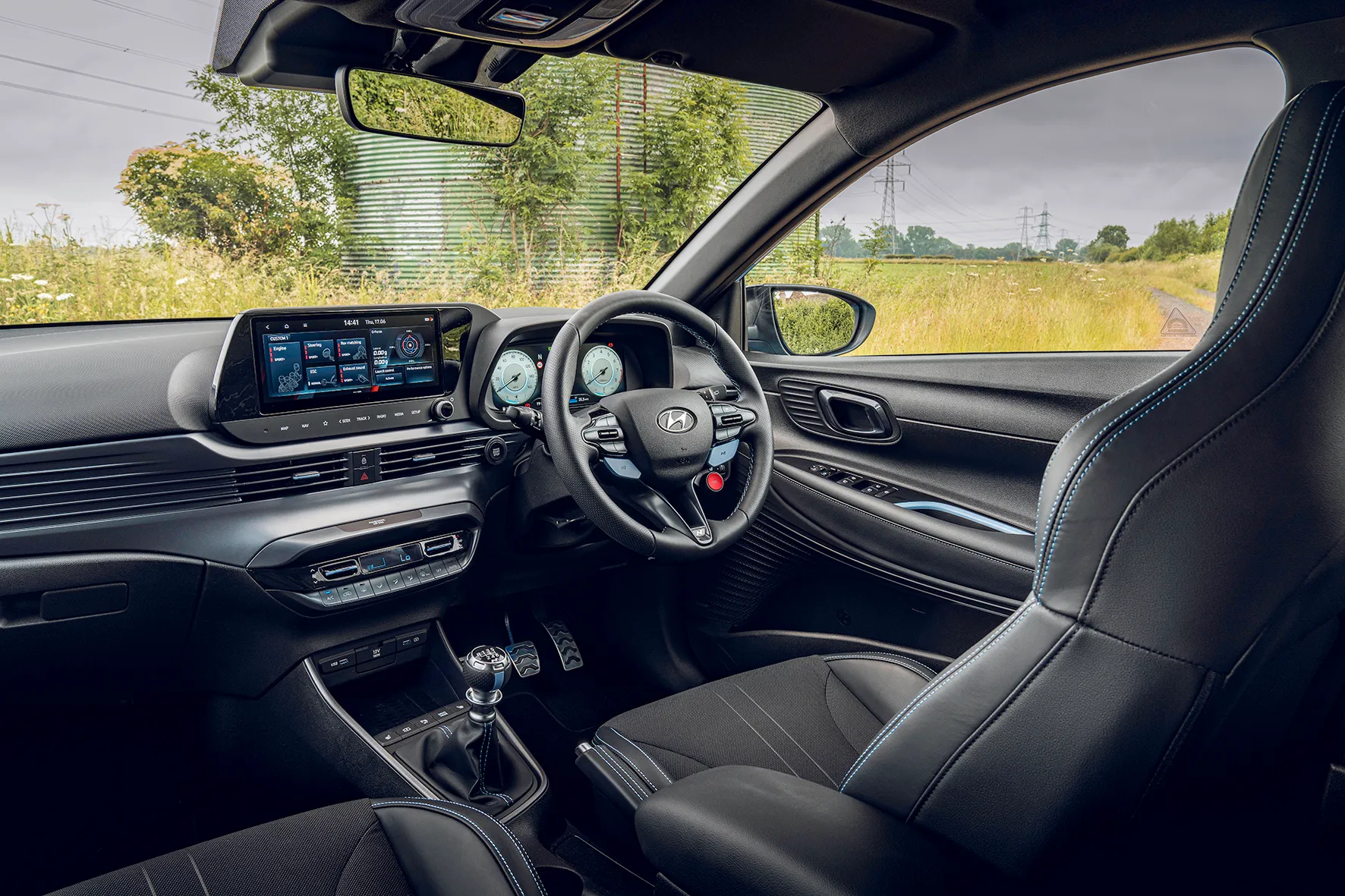
The dashboard layout in the Hyundai i20N is pretty traditional, meaning that most of the various controls sit where you expect to find them, and thankfully, most take the form of traditional buttons, dials and switches. That means you don’t have to mess around with complicated touchscreens or fussy touch-sensitive sliders every time you want to change the cabin temperature or crank up the stereo volume.
There’s a good range of adjustment on the steering wheel and driver’s seat, meaning most drivers should be able to make themselves comfy at the wheel. There’s no lumbar adjustment, but the seats are supportive enough that it shouldn’t bother most people.
Forward visibility is good thanks to slim windscreen pillars, but the equivalent pillars flanking the rear screen are pretty chunky, which can hamper your rear view, so it’s a good job that rear parking sensors and a reversing camera are standard-issue.
Quality and finish
Hyundai has made some effort to jazz up the N’s cabin in comparison to that of the regular i20. You get chunky sports front seats, leather coverings for the steering wheel and gear lever, aluminium sports pedals, blue ambient lighting and, of course, a liberal smattering of N badging.
However, while it does manage to feel a bit racier than a regular i20, it doesn’t feel any posher, because you have the same monotonous grey colour scheme and the same drab-feeling plastic panels. This rather dour feel isn’t ideal in a regular i20, but in a range-topping hot hatch, it becomes even more noticeable.
Infotainment: Touchscreen, USB, nav and stereo in the Hyundai i20N
The Hyundai i20N’s infotainment system is centred around a 10.25-inch touchscreen that sits in the middle of the dashboard, and the system has all the functionality you’d expect as standard. That includes Bluetooth, voice control, DAB, Apple CarPlay, Android Auto, six speakers and USBs in both the front and the back. It also includes a couple of things you might not expect at this end of the market, including native sat-nav and a wireless phone charging pad. You can also upgrade the stereo to a BOSE premium sound system as an optional extra.
The touchscreen system itself isn’t the best you’ll come across, which is a bit surprising given that Hyundai usually does really well in this area. The graphics and menu layouts are fine, but the software is slow and takes an annoyingly long time to react to inputs, to the point where you’re often left wondering if your input registered at all.
The standard kit list also includes a 10.25-inch digital driver’s display rather than conventional instruments, which is a pleasant high-end touch, and it’s easy to read and can be configured in a wide variety of ways.
Space and practicality: Hyundai i20N boot space
Part of the appeal of a hot hatch is that not only can it spice up your life with a raucous driving experience, but it also has enough practicality to deal with all the boring bits of life, too. This is something that’s not been forgotten in the i20N, and it does a cracking job given its small size. The front seats have plenty of room, as you’d expect, but there’s enough enough headroom and legroom in the rear seats to keep a couple of tall six-foot-plus adults happy. The cabin is too narrow to comfortably fit a third chum in across the rear bench for any length of time, but the same is true of pretty much all cars this size.
The boot is also a very decent size at 352 litres, which compares well with those of rivals, and there’s a movable floor that allows you to either maximise load volume or level off the (already pretty small) load lip. It also levels off the step up to the rear seatbacks when you fold them down to maximise load volume, and these fold in a conventional 60/40 arrangement.
Handling and ride quality: What is the Hyundai i20N like to drive?
"If you’re on the right road and in the right mood, the i20N is a tremendously enjoyable car to drive, and one that encourages you to unleash your inner delinquent. When you’re not in the mood, or the road conditions require a more relaxed driving style, though, you’ll quickly notice some fairly hefty compromises in everyday useability."
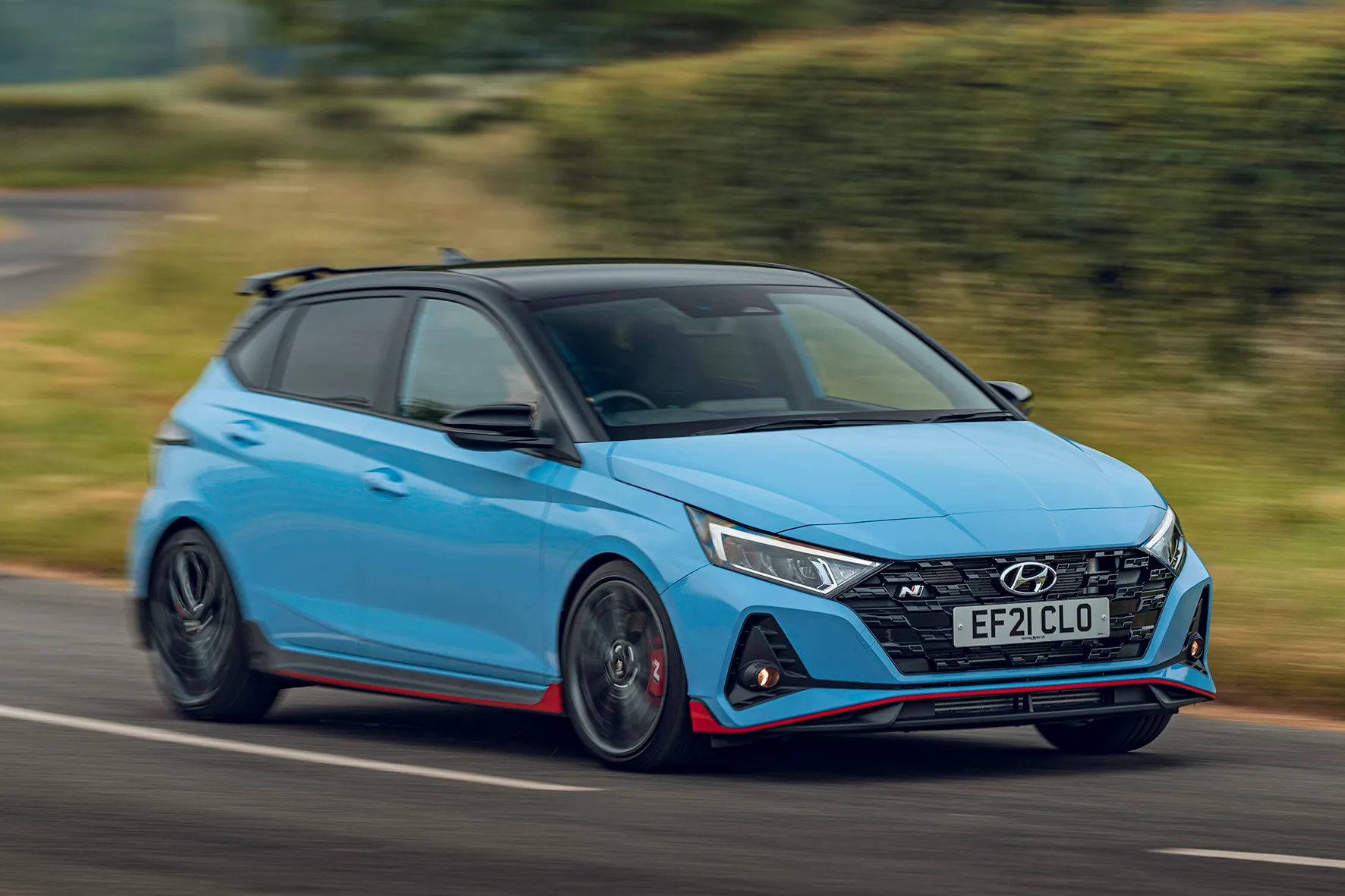
Quite simply, the Hyundai i20N is an utter hooligan of a thing. Put it on the right road, in the right conditions, with your mood in an appropriately devil-may-care place, and it’s an absolute riot.
That’s perhaps no surprise when so much technology has been thrown at the car to make it sing in a set of bends. There’s a limited-slip differential to maximise traction and grip at the front end - both of which are nothing short of mighty, by the way - and you also have launch control, automatic rev-matching, and last but not least, multiple drive modes that vary the behaviour of various things like the diff, the steering, the throttle and the exhaust to dial the excitement levels up or down according to your mood. You’ll probably also like the fact that it has a manual handbrake rather than one of those boring electronic ones, allowing you to relive your teenage days by pulling totally pointless skids in deserted car parks, should you so wish.
But get out of the deserted car park and out onto the open road, and you’ll discover a car that combines those huge grip levels and strong performance (more on that in a minute) with extremely strong body control, weighty and responsive steering and a generally neutral-feeling balance, making the N a monumentally entertaining car, and one that’s very easy to drive very quickly. Okay, so it doesn’t quite have the polished dynamic slickness of the Ford Fiesta ST, and feels a bit more like a blunt instrument as a result, but there's certainly no shortage of fun to be had.
Now, that all sounds great, but there is a slight problem with the N, and that’s that it’s something of a one-trick pony. You see, the N only feels completely happy when you’re driving it like your hair's on fire, and in truth, you’ll only ever be able to do that for a fraction of the time. Back off even a little bit, and you’ll notice some fairly hefty compromises. The ride, for example, is punishingly hard, and being bounced around quite so violently when you’re popping to the shops or trying to negotiate an early-morning school run will likely get very old very quickly. During such use, you might also find that the steering starts to feel unnecessarily heavy, while the way that the diff hops and creaks during full-lock parking manoeuvres will also set your teeth on edge. What’s more, the presence of the diff and the large wheels mean that the turning circle is hopeless, so be prepared for plenty of five-point (maybe even some seven-point ) turns.
What engines and gearboxes are available in the Hyundai i20N?
This being the high-performance N version of the i20, there’s only one of each, and that’s a turbocharged 1.6-litre four-cylinder petrol engine, mated to a six-speed manual gearbox. The engine sends 204PS to the front wheels, with traction aided by a limited-slip differential, while a launch control function is also provided as standard. Engage that, and the Hyundai i20N is capable of sprinting from 0-62mph in 6.2 seconds, which is quick enough to raise a smile on even the grouchiest set of chops.
You will feel the steering wheel squirm slightly as the power gets put down, but it’s not as bad as in some rival hot hatches, and the rate at which you get away from the mark feels appropriately rapid. The speed builds in a linear way as the revs rise, which feels nice and consistent, even though it doesn’t quite have the same boosty, highly flexible nature as the engine in a Ford Fiesta ST. That means you’ll need to make a few more gearshifts than you will in the Ford when you want to get a wriggle-on, but that’s no hardship because the shift action feels swift and precise, if not quite as creamily slick as the Fiesta’s.
The N also comes with a rev-matching feature that automatically blips the throttle on downshifts, and it works really well, but if you prefer to do this for yourself with some of your own heel-and-toe heroics, the system is easy to turn off.
The only slight disappointment in this area is the slightly lazy throttle response, which is admittedly reduced in the raciest of the various driving modes, but is still present. There’s an appreciable delay between pushing the go pedal and that go actually arriving, and this takes the edge off the feeling of urgency and dynamic sharpness ever so slightly.
Refinement and noise levels
Like many modern hot hatches, the Hyundai i20N’s engine sound is augmented synthetically. In many such cases, the results of such technology are rather unconvincing, but we’re happy to report that in the Hyundai, the effect is rather more plausible. The pleasant burble varies in intensity depending on the driving mode selected, and when the engine is fully extended, you’re treated to an appealing howl.
The noise from the engine isn’t quite so welcome when you’re sitting on the motorway at the national speed limit, because you can hear it buzzing away, although it’s not noisy enough to test your patience too much. The same goes for wind- and road noise: both are detectable, but not too troublesome.
Safety equipment: How safe is the Hyundai i20N?
As we’ve mentioned, the Hyundai i20N has that mechanical limited-slip differential to help keep all its power going in the right direction, and on top of that, you’ve got all the usual electronic traction and stability systems to help further. Other electronic driver aids that come as standard include forward collision alert with automatic emergency braking, speed limit recognition, driver attention alert, lane keep assist and lane departure warning. If all this stuff isn’t enough to prevent you from having a crash in the first place, there are also a range of means to help keep you from harm should the worst happen. These include six airbags, Isofix child seat mounting points in the rear seats and an eCall emergency alert system.
Officially, the i20 has a four-star crash test rating from Euro NCAP, but it’s not altogether clear whether the mechanical differences in the N version would make it perform any better or worse in a smash. The water is also muddied further by the fact that the vehicle that actually took part in the test was a Bayon SUV, and it was deemed that the two cars are sufficiently similar that the rating can also be applied to the i20.
MPG and fuel costs: What does a Hyundai i20N cost to run?
"The Hyundai i20N is reasonably priced as a new car compared with rivals, but its relative rarity means that used car prices aren’t that much lower. It should be fairly affordable to run, though, with decent fuel economy given its level of power, and very reasonable servicing costs. Great warranty, too."
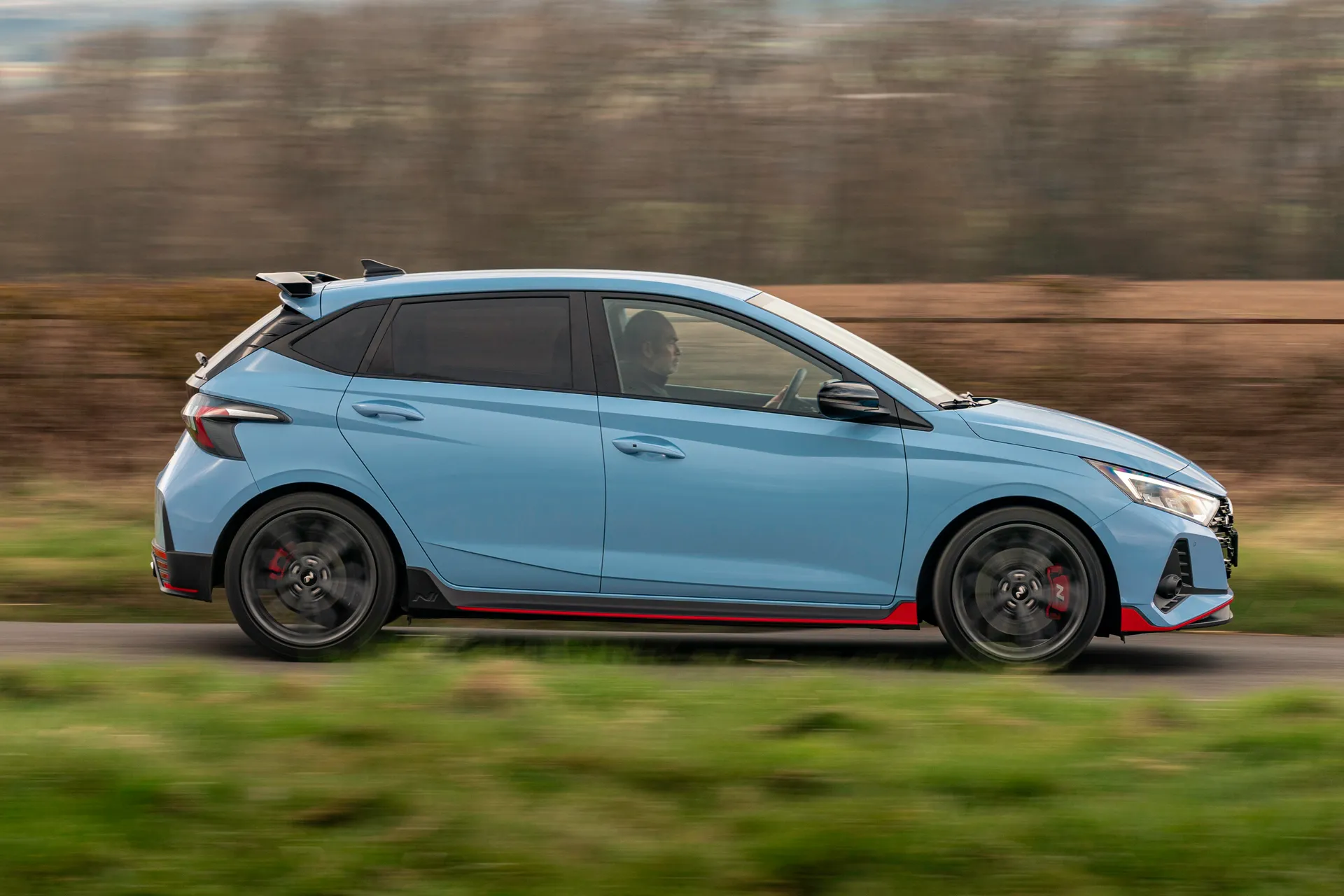
According to the official WLTP figures, you should be able to get a fuel economy return of 40.4mpg from the Hyundai i20N. Like with any car, what you’ll get in the real world will depend entirely on how you drive it, and given its character, the i20N will probably goad you into ruining your economy with over-enthusiastic use of your right foot on a fairly regular basis. And in fairness, if it doesn’t, then you’re probably driving the wrong sort of car. Importantly, our time with the car suggested that you should be able to get fairly close to the official figure, provided you don’t give into temptation. Well, not too often, anyway.
How reliable is the Hyundai i20N?
If Hyundai’s reputation in this area is anything to go by, there should be very little to worry about. Out of the 29 manufacturers considered in the most recent HonestJohn.co.uk Satisfaction Index, Hyundai was rated as the 7th best brand for overall customer satisfaction, and 9th best for reliability specifically. Granted, the high-performance Hyundai i20N may be a little more highly strung than most of the firm’s other models, but it’s still backed by the same five-year, unlimited-mileage warranty, which is one of the most generous in the industry.
Insurance groups and costs
Nice, easy one, this, considering there’s only one version. The Hyundai i20N sits in insurance group 27 out of 50 (group 1 cars being the cheapest to insure, group 50 cars being the most expensive) so expect middling premiums. This is roughly similar to the classification of the Volkswagen Polo GTI, but quite a bit lower than that of the Suzuki Swift Sport, which has far less power, but is comparatively expensive to repair, according to insurers.
VED car tax: What is the annual road tax on a Hyundai i20N?
Another easy one. As a post-2017 petrol-powered model, you pay the same flat rate of road tax on the i20N as you do on all purely combustion-engined models of the day. That means an annual bill of £180, and because no version of the Hyundai i20N costs over the £40,000 ‘luxury car’ threshold, even if you fit every possible optional extra, then no example will be subject to the £380 per-year surcharge,
How much should you be paying for a used Hyundai i20N?
"Due to its rarity on the used car market, and the abnormal strength of used car prices in general, the value of used examples of the i20N hasn’t fallen very far yet, so you’re likely to pay almost as much - if not more - for a used one than a brand new one right now."
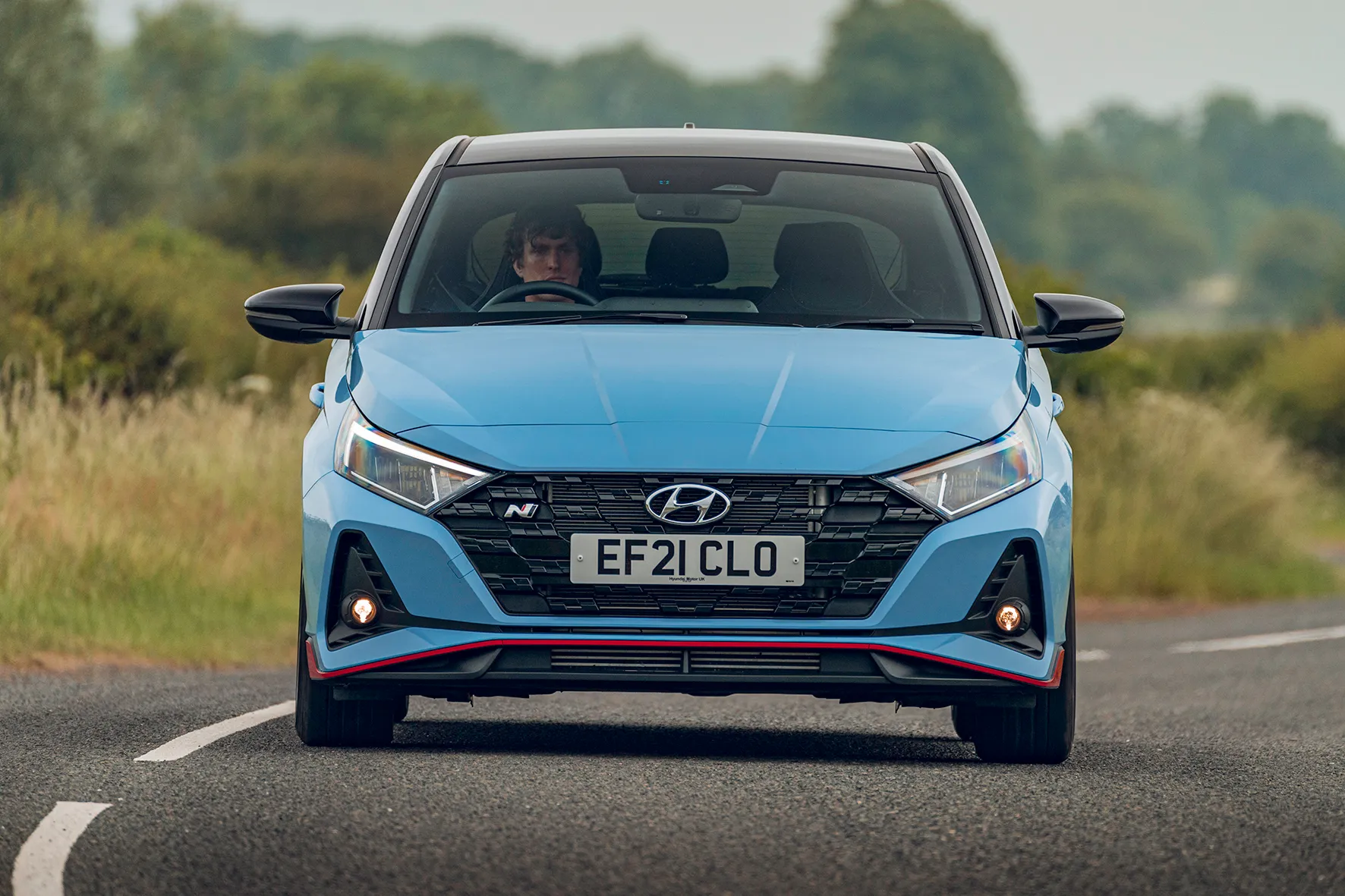
Currently, prices for brand new examples of the Hyundai i20N start at around £26,500, which has gone up a wee bit since the car was first launched in 2021. That’s a bit more than you’ll pay for a Suzuki Swift Sport, which has considerably less power, but a bit less than you’ll pay for a VW Polo GTI. A Toyota GR Yaris will set you back a few grand more still, but although similar in size, it’s a very different type of car.
And because used car prices have been elevated so abnormally throughout its time on sale, and used examples of the Hyundai i20N aren’t exactly commonplace, the car’s value has stayed largely solid since. Browse our listings, and you might find to odd example with a couple of years and a few thousand miles under its wheels for a fairly useful four-figure saving, but prices haven’t dipped much further than that, and most examples you’ll find are less than a year old and have negligible mileage, and these are going for almost as much as brand new examples, sometimes even more because you’re not having to wait for the thing to be built and shipped. We expect prices to come down a bit more as time goes on, and as the car market returns to more normal economic conditions.
Trim levels and standard equipment
Those interested in the i20N will want it to look the part, and to that end, it comes festooned with sporty styling touches including 18-inch alloy wheels, all-round LED lights, rear privacy glass, various black-finish styling elements, and skirts, spoilers and aprons aplenty. Most of the few optional extras available on the car are also aesthetic, including metallic or pearlescent paint, and a contrasting black roof.
The roster of standard luxury kit is pretty good, too. You get part-leather upholstery, heated front seats, a heated steering wheel, automatic lights and wipers, automatic high-beam assist, cruise control, power folding door mirrors, keyless entry and go, rear parking sensors and a reversing camera. Other than the aesthetic ones, the only optional extra available is the BOSE stereo system we mentioned earlier.
Ask the heycar experts: common questions
What does the N stand for in i20N?
What's the difference between Hyundai N and N-Line?
Is the Hyundai i20N a good hot hatch?
Get our latest advice, news and offers
Keep me updated by email with the latest advice, news and offers from heycar.
By submitting you agree to our privacy policy
